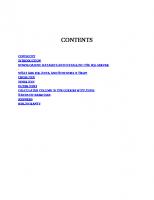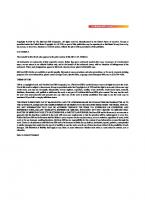Mastering SQL: A Beginner's Guide 9781032415093, 9781032415062, 9781003358435
The book is a detailed guide for beginners to understand SQL. This book will cover all the basic knowledge as to how you
147 52 2MB
English Pages 446 Year 2023
Table of contents :
CHAPTER 1 ◾ Basics about SQL
In This Chapter
Relational Database Management System (RDBMS)
Keys in SQL
What Is Structured Query Language (SQL)?
Origins of Structured Query Language (SQL)
Purpose of Structured Query Language (SQL)
Installations of SQL
Operations in Structured Query Language (SQL)
What Are the Different Types of Functions?
Aggregated Functions
Scalar Functions
Characteristics of Structured Query Language (SQL)
Foundational Relationships
High Performance
Scalability
Authentication and Security
Independent Vendors
Adaptability to a Variety of Computer Systems
Endorsement and Commitment from IBM (DB2)
Structure Similar to That of English
Database Access through Programming
Transaction Control Language
Various Viewpoints on Data
Dynamic
Architecture of Client/Server
SQL with Java Integration
Some SQL Statements
Advantages of Structured Query Language (SQL)
Disadvantages of Structured Query Language (SQL)
Data Types in Structured Query Language (SQL)
Exact Numeric Data Types
Types of Numeric Data
Types of Date and Time Data
Data Types for Character Strings
Character String Data Types in Unicode
Types of Binary String Data
Other Data Types
Commands of Structured Query Language (SQL)
Data Definition Language (DDL)
Make a Database
Make a Table
Add to Table
Drop a Table
Data Manipulation Language (DML)
Data Control Language (DCL)
Transition Control Language (TCL)
Transactions in SQL
Characteristics of Transactional
Commands for Controlling Transactions
Commands for Transactional Control
Set Transaction
Views in SQL
Views Are Being Removed
Views Are Being Updated
Delete a Row from a View
With Check Option
Views and Their Applications
SQL Comments
Constraints in SQL
SQL Creating Role
Making a Role and Assigning It
SQL Indexes
Unique Indexes
Clustered Index
Non-Clustered Indexes
When Should You Construct Indexes?
When Indexes Should Be Avoided
Drop Index
Altering Index
Confirming Indexes
Renaming an Index
Sequences in SQL
Query Processing in SQL
Common Table ExpressionS (CTE) in SQL
Defining CTEs
Creating a Common Table Expression (Recursive)
Types of Common Table Expressions
Triggers in SQL
Before and After Triggers
Book Management Database in SQL Trigger
Introduction to NoSQL (Non-Relational SQL)
A Brief History of NoSQL Databases
Types of NoSQL Databases
Key-Value
Column-Based
Document-Oriented
Graph-Based
Features of NoSQL
Non-Relational Database Management System (NoSQL) Features
Schema-Free
API That Is Easy to Use
Distributed
NoSQL Query Mechanism Tools
What Is the CAP Theorem, and How Does It Work?
Consistency
Availability
Tolerance for Partitions
Consistency in the Long Run
When Should You Utilise NoSQL?
Advantages
Disadvantages
Summary
Note
CHAPTER 2 ◾ Clauses/Operators
In This Chapter
With Clause in SQL
With Ties Clause in SQL
Arithmetic Operators in SQL
Addition Operator (+)
Subtraction Operator (–)
Operator for Multiplication (*)
Division Operator (/)
Modulus Operator(%)
Wildcard in SQL: An Overview
SQL Wildcards Syntax
Except and Intersect Operators
Except Clause
Using Clause
Knowing How to Use the SQL Merge Statement
SQL Merge Command and its Applications
Improving the SQL Merge Statement’s Performance
Merge Statement in SQL Explained
DDL, DML, DCL and TCL Commands
Create Domain in SQL
Create a New Domain
Describe Statement
Case Statement in SQL
Syntax of SQL Case Statements
Unique Constraints in SQL
Contrasting the Primary Key and Unique Constraints
Unique Constraints for a Group of Columns
Add Unique Constraints to Existing Columns
The Alter Table Drop Constraint Statement
Create Table Extension
Rename in SQL
Add, Drop, Modify
Table Change – Add
Change Table – Drop
Modify the Table
Limit Clause
A Limit Clause: What Is It?
What are the Definition, Syntax, and Parameter Values of a Select Limit Statement?
Parameters or Arguments
Using the Limit Keyword
When Should the Limit Clause Be Used?
The Limit Clause’s Benefits
Insert Ignore Statement
How Does MySQL’s Insert Ignore Function Work?
Drawback
Like Operator
Some SQL Operator
Offset Fetch in SQL Server
Application of Offset and Fetch Offset
Fetch and Offset
Offset Only
Fetch Only
SQL Statement Except
Prerequisites for the SQL Except Statement
Using Joins and the Over Clause in SQL to Combine Aggregate and Non-Aggregate Values
Utilising Joins
Over Clause
Operators for SQL Any and ALL
ANY Operator in SQL
SQL Operator ALL
Exists in SQL
Group by Statement in SQL
Union Clause
Union Versus Union All
In SQL, An Example of the Union Operator
Where Clause Is Combined with the Union Operator
Union All Operator in SQL
Example of Union All
SQL in Aliases
Order by Clause in SQL
Select Top Clause in SQL
Top Clause Syntax in SQL Server
SQL Select the Highest Percentage of Records to Return
Multiple Select Top Statements
SQL Update Command
Delete Statement in SQL
Insert into SQL Statement
AND and OR SQL Operators
AND Operator
Combining AND and OR
Clause Where
Unique Clause in SQL
Select in SQL Statement
Where Clause in Select Statement
Group by Clause in SQL Select Statement
Select Statement with Group by Clause Example
Having Clause in SQL Select Statement
Order by Clause in Select Statement
Drop and Truncate Table in SQL
Truncate Table in SQL
Table Drop in SQL
Create in SQL
Make a Database
Table Creation
Joins in SQL
Alternate Quote Operator
Operator for Concatenation
Operator Minus
Division Operator
The NOT Operator in SQL
Between and In Operator
Between Operator
The SQL Syntax
In Operator
Join (Inner, Left, Right and Full Joins)
Different Types of Joins
How to Determine Which SQL Join to Use
Inner Joining
Full Joining
Join on the Left
Right Joining
SQL Constraint Check
Summary
CHAPTER 3 ◾ SQL Injections
In This Chapter
What is SQL Injection (SQLi)?
Goals of SQLi
Mechanism of SQL Injection Attack
SQL Injection Types
Detection and Prevention of SQL Injection Attacks
Simple SQLi Example
Sqlmap: Test a Website SQL Injection Vulnerability
Sqlmap
Features of Sqlmap
How to Download
Where Sqlmap May Be Used
Damn Vulnerable Web Application (DVWA)
Determine the Database Management System (DBMS) in the Site
Listing of Tables in a Database
Getting Rid of a Table
Mitigating the SQL Injection Attack with Prepared Declarations
Prepared Statements
Mechanism of Action of Prepared Statements
Terminology
What is the Benefit of Utilising a Prepared Statement in Java?
What about Sanitization of the Input?
Summary
Notes
CHAPTER 4 ◾ SQL Functions
In This Chapter
SQL Functions
Aggregate Functions
Analytic Functions
Scalar SQL Functions
SQL Server Mathematical Functions
Conversion Function
Explicit vs. Implicit
Conversion of Implicit Data Types
SQL Conversion of Explicit Data Types Conversion
Using the TO CHAR Function with Dates
Using the TO CHAR Function with Numbers
The to Number and to Date Functions
General Functions in SQL
NVL()
NVL2 Function
DECODE()
COALESCE()
NULLIF()
LVL()
Conditional Statements in SQL
Case Statement in SQL
IF Proclamation in SQL
Character Functions
Case-Manipulative Functions
Character-Manipulative Functions
Listing Function
The On Overflow Statement
Distinct
Combining Listing with Filter and Over
Compatibility
Arrays
Document Types
Using with Recursive
Proprietary Extensions
Proprietary Alternatives
Aggregate Function in SQL
Date Functions
Null Values in SQL
Why Are Null Functions Necessary?
How Can Null Values Be Tested?
Is Null Syntax
Is Not Null Syntax
Numeric Functions
String Functions
Deterministic and Nondeterministic
Built-in Function Determinism
Summary
Note
BIBLIOGRAPHY
INDEX
CHAPTER 1 ◾ Basics about SQL
In This Chapter
Relational Database Management System (RDBMS)
Keys in SQL
What Is Structured Query Language (SQL)?
Origins of Structured Query Language (SQL)
Purpose of Structured Query Language (SQL)
Installations of SQL
Operations in Structured Query Language (SQL)
What Are the Different Types of Functions?
Aggregated Functions
Scalar Functions
Characteristics of Structured Query Language (SQL)
Foundational Relationships
High Performance
Scalability
Authentication and Security
Independent Vendors
Adaptability to a Variety of Computer Systems
Endorsement and Commitment from IBM (DB2)
Structure Similar to That of English
Database Access through Programming
Transaction Control Language
Various Viewpoints on Data
Dynamic
Architecture of Client/Server
SQL with Java Integration
Some SQL Statements
Advantages of Structured Query Language (SQL)
Disadvantages of Structured Query Language (SQL)
Data Types in Structured Query Language (SQL)
Exact Numeric Data Types
Types of Numeric Data
Types of Date and Time Data
Data Types for Character Strings
Character String Data Types in Unicode
Types of Binary String Data
Other Data Types
Commands of Structured Query Language (SQL)
Data Definition Language (DDL)
Make a Database
Make a Table
Add to Table
Drop a Table
Data Manipulation Language (DML)
Data Control Language (DCL)
Transition Control Language (TCL)
Transactions in SQL
Characteristics of Transactional
Commands for Controlling Transactions
Commands for Transactional Control
Set Transaction
Views in SQL
Views Are Being Removed
Views Are Being Updated
Delete a Row from a View
With Check Option
Views and Their Applications
SQL Comments
Constraints in SQL
SQL Creating Role
Making a Role and Assigning It
SQL Indexes
Unique Indexes
Clustered Index
Non-Clustered Indexes
When Should You Construct Indexes?
When Indexes Should Be Avoided
Drop Index
Altering Index
Confirming Indexes
Renaming an Index
Sequences in SQL
Query Processing in SQL
Common Table ExpressionS (CTE) in SQL
Defining CTEs
Creating a Common Table Expression (Recursive)
Types of Common Table Expressions
Triggers in SQL
Before and After Triggers
Book Management Database in SQL Trigger
Introduction to NoSQL (Non-Relational SQL)
A Brief History of NoSQL Databases
Types of NoSQL Databases
Key-Value
Column-Based
Document-Oriented
Graph-Based
Features of NoSQL
Non-Relational Database Management System (NoSQL) Features
Schema-Free
API That Is Easy to Use
Distributed
NoSQL Query Mechanism Tools
What Is the CAP Theorem, and How Does It Work?
Consistency
Availability
Tolerance for Partitions
Consistency in the Long Run
When Should You Utilise NoSQL?
Advantages
Disadvantages
Summary
Note
CHAPTER 2 ◾ Clauses/Operators
In This Chapter
With Clause in SQL
With Ties Clause in SQL
Arithmetic Operators in SQL
Addition Operator (+)
Subtraction Operator (–)
Operator for Multiplication (*)
Division Operator (/)
Modulus Operator(%)
Wildcard in SQL: An Overview
SQL Wildcards Syntax
Except and Intersect Operators
Except Clause
Using Clause
Knowing How to Use the SQL Merge Statement
SQL Merge Command and its Applications
Improving the SQL Merge Statement’s Performance
Merge Statement in SQL Explained
DDL, DML, DCL and TCL Commands
Create Domain in SQL
Create a New Domain
Describe Statement
Case Statement in SQL
Syntax of SQL Case Statements
Unique Constraints in SQL
Contrasting the Primary Key and Unique Constraints
Unique Constraints for a Group of Columns
Add Unique Constraints to Existing Columns
The Alter Table Drop Constraint Statement
Create Table Extension
Rename in SQL
Add, Drop, Modify
Table Change – Add
Change Table – Drop
Modify the Table
Limit Clause
A Limit Clause: What Is It?
What are the Definition, Syntax, and Parameter Values of a Select Limit Statement?
Parameters or Arguments
Using the Limit Keyword
When Should the Limit Clause Be Used?
The Limit Clause’s Benefits
Insert Ignore Statement
How Does MySQL’s Insert Ignore Function Work?
Drawback
Like Operator
Some SQL Operator
Offset Fetch in SQL Server
Application of Offset and Fetch Offset
Fetch and Offset
Offset Only
Fetch Only
SQL Statement Except
Prerequisites for the SQL Except Statement
Using Joins and the Over Clause in SQL to Combine Aggregate and Non-Aggregate Values
Utilising Joins
Over Clause
Operators for SQL Any and ALL
ANY Operator in SQL
SQL Operator ALL
Exists in SQL
Group by Statement in SQL
Union Clause
Union Versus Union All
In SQL, An Example of the Union Operator
Where Clause Is Combined with the Union Operator
Union All Operator in SQL
Example of Union All
SQL in Aliases
Order by Clause in SQL
Select Top Clause in SQL
Top Clause Syntax in SQL Server
SQL Select the Highest Percentage of Records to Return
Multiple Select Top Statements
SQL Update Command
Delete Statement in SQL
Insert into SQL Statement
AND and OR SQL Operators
AND Operator
Combining AND and OR
Clause Where
Unique Clause in SQL
Select in SQL Statement
Where Clause in Select Statement
Group by Clause in SQL Select Statement
Select Statement with Group by Clause Example
Having Clause in SQL Select Statement
Order by Clause in Select Statement
Drop and Truncate Table in SQL
Truncate Table in SQL
Table Drop in SQL
Create in SQL
Make a Database
Table Creation
Joins in SQL
Alternate Quote Operator
Operator for Concatenation
Operator Minus
Division Operator
The NOT Operator in SQL
Between and In Operator
Between Operator
The SQL Syntax
In Operator
Join (Inner, Left, Right and Full Joins)
Different Types of Joins
How to Determine Which SQL Join to Use
Inner Joining
Full Joining
Join on the Left
Right Joining
SQL Constraint Check
Summary
CHAPTER 3 ◾ SQL Injections
In This Chapter
What is SQL Injection (SQLi)?
Goals of SQLi
Mechanism of SQL Injection Attack
SQL Injection Types
Detection and Prevention of SQL Injection Attacks
Simple SQLi Example
Sqlmap: Test a Website SQL Injection Vulnerability
Sqlmap
Features of Sqlmap
How to Download
Where Sqlmap May Be Used
Damn Vulnerable Web Application (DVWA)
Determine the Database Management System (DBMS) in the Site
Listing of Tables in a Database
Getting Rid of a Table
Mitigating the SQL Injection Attack with Prepared Declarations
Prepared Statements
Mechanism of Action of Prepared Statements
Terminology
What is the Benefit of Utilising a Prepared Statement in Java?
What about Sanitization of the Input?
Summary
Notes
CHAPTER 4 ◾ SQL Functions
In This Chapter
SQL Functions
Aggregate Functions
Analytic Functions
Scalar SQL Functions
SQL Server Mathematical Functions
Conversion Function
Explicit vs. Implicit
Conversion of Implicit Data Types
SQL Conversion of Explicit Data Types Conversion
Using the TO CHAR Function with Dates
Using the TO CHAR Function with Numbers
The to Number and to Date Functions
General Functions in SQL
NVL()
NVL2 Function
DECODE()
COALESCE()
NULLIF()
LVL()
Conditional Statements in SQL
Case Statement in SQL
IF Proclamation in SQL
Character Functions
Case-Manipulative Functions
Character-Manipulative Functions
Listing Function
The On Overflow Statement
Distinct
Combining Listing with Filter and Over
Compatibility
Arrays
Document Types
Using with Recursive
Proprietary Extensions
Proprietary Alternatives
Aggregate Function in SQL
Date Functions
Null Values in SQL
Why Are Null Functions Necessary?
How Can Null Values Be Tested?
Is Null Syntax
Is Not Null Syntax
Numeric Functions
String Functions
Deterministic and Nondeterministic
Built-in Function Determinism
Summary
Note
BIBLIOGRAPHY
INDEX

- Author / Uploaded
- Sufyan bin Uzayr









